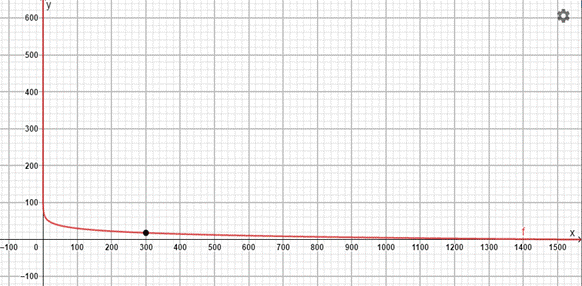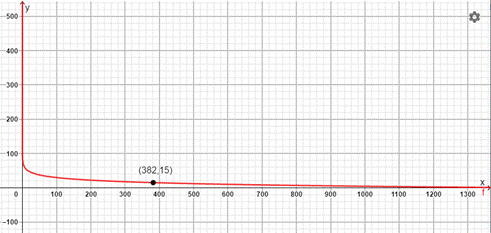
(a).
Tograph : the given function and approximate the required rate of ventilation in a room with
(a).
Explanation of Solution
Given information :
The model:
The model approximates the minimum required rate of ventilation y (in cubic feet per minute per child) in a classroom with x cubic feet of air space per child.
The cubic feet of air space per child,
Graph :
As per the problem,
For the function,
Sketch the graph using graphing utility.
Step 1: Press WINDOW button to access the Window editor.
Step 2: Press
Step 3: Enter the expression,
Step 4: Press GRAPH button to graph the functions.

Interpretation:From the graph,

Therefore, for
(b).
Tocalculate : the rate of ventilation per child.
(b).
Answer to Problem 114E
The rate of ventilation is
Explanation of Solution
Given information :
The model:
The model approximates the minimum required rate of ventilation y (in cubic feet per minute per child) in a classroom with x cubic feet of air space per child.
Total number of students in the classroom is
The total cubic feet of air per minute is
Calculation :
As per the problem,
Total number of students in the classroom is
The total cubic feet of air per minute is
The rate of ventilation y is the cubic feet of air per minute per child.
Therefore,
(c).
Toestimate : the minimum required air space per child for the classroom in part(b), using the graph obtained in part(a).
(c).
Answer to Problem 114E
Explanation of Solution
Given information :
Consider the graph obtained in part (a).
The rate of ventilation per child,
As per the problem,
Consider the graph obtained in part (a):

From the graph, for
Therefore, the minimum required air space per child for the classroom, having
(d).
Toexplain : the rate of ventilation is adequate for the classroom in part (b) having the given volume.
(d).
Answer to Problem 114E
The rate of ventilation for the classroom,
Explanation of Solution
Given information :
The classroom of
Therate of ventilation for the classroom having
The model:
The model approximates the minimum required rate of ventilation y (in cubic feet per minute per child) in a classroom with x cubic feet of air space per child.
As per the problem,
Total students in the classroom is
The floor space of the classroom is
The height of the ceiling of the classroom is
Therefore, volume of the classroom or the total cubic feet of air spaceis
The cubic feet of air space per child is
Substitute
Therefore, the minimum required rate of ventilation for the classroom is
Thus, the rate of ventilation for the classroom,
Chapter 3 Solutions
EP PRECALC.GRAPHING APPR.-WEBASSIGN-1YR
- Given lim x-4 f (x) = 1,limx-49 (x) = 10, and lim→-4 h (x) = -7 use the limit properties to find lim→-4 1 [2h (x) — h(x) + 7 f(x)] : - h(x)+7f(x) 3 O DNEarrow_forward17. Suppose we know that the graph below is the graph of a solution to dy/dt = f(t). (a) How much of the slope field can you sketch from this information? [Hint: Note that the differential equation depends only on t.] (b) What can you say about the solu- tion with y(0) = 2? (For example, can you sketch the graph of this so- lution?) y(0) = 1 y ANarrow_forward(b) Find the (instantaneous) rate of change of y at x = 5. In the previous part, we found the average rate of change for several intervals of decreasing size starting at x = 5. The instantaneous rate of change of fat x = 5 is the limit of the average rate of change over the interval [x, x + h] as h approaches 0. This is given by the derivative in the following limit. lim h→0 - f(x + h) − f(x) h The first step to find this limit is to compute f(x + h). Recall that this means replacing the input variable x with the expression x + h in the rule defining f. f(x + h) = (x + h)² - 5(x+ h) = 2xh+h2_ x² + 2xh + h² 5✔ - 5 )x - 5h Step 4 - The second step for finding the derivative of fat x is to find the difference f(x + h) − f(x). - f(x + h) f(x) = = (x² x² + 2xh + h² - ])- = 2x + h² - 5h ])x-5h) - (x² - 5x) = ]) (2x + h - 5) Macbook Proarrow_forward
- Evaluate the integral using integration by parts. Sx² cos (9x) dxarrow_forwardLet f be defined as follows. y = f(x) = x² - 5x (a) Find the average rate of change of y with respect to x in the following intervals. from x = 4 to x = 5 from x = 4 to x = 4.5 from x = 4 to x = 4.1 (b) Find the (instantaneous) rate of change of y at x = 4. Need Help? Read It Master Itarrow_forwardVelocity of a Ball Thrown into the Air The position function of an object moving along a straight line is given by s = f(t). The average velocity of the object over the time interval [a, b] is the average rate of change of f over [a, b]; its (instantaneous) velocity at t = a is the rate of change of f at a. A ball is thrown straight up with an initial velocity of 128 ft/sec, so that its height (in feet) after t sec is given by s = f(t) = 128t - 16t². (a) What is the average velocity of the ball over the following time intervals? [3,4] [3, 3.5] [3, 3.1] ft/sec ft/sec ft/sec (b) What is the instantaneous velocity at time t = 3? ft/sec (c) What is the instantaneous velocity at time t = 7? ft/sec Is the ball rising or falling at this time? O rising falling (d) When will the ball hit the ground? t = sec Need Help? Read It Watch Itarrow_forward
- Find the slope of the tangent line to the graph of the function at the given point. f(x) = -4x + 5 at (-1, 9) m Determine an equation of the tangent line. y = Need Help? Read It Watch It SUBMIT ANSWERarrow_forwardFind the slope of the tangent line to the graph of the function at the given point. f(x) = 5x-4x² at (-1, -9) m Determine an equation of the tangent line. y = Need Help? Read It Master It SUBMIT ANSWERarrow_forwardFor what value of A and B the function f(x) will be continuous everywhere for the given definition?..arrow_forward
 Calculus: Early TranscendentalsCalculusISBN:9781285741550Author:James StewartPublisher:Cengage Learning
Calculus: Early TranscendentalsCalculusISBN:9781285741550Author:James StewartPublisher:Cengage Learning Thomas' Calculus (14th Edition)CalculusISBN:9780134438986Author:Joel R. Hass, Christopher E. Heil, Maurice D. WeirPublisher:PEARSON
Thomas' Calculus (14th Edition)CalculusISBN:9780134438986Author:Joel R. Hass, Christopher E. Heil, Maurice D. WeirPublisher:PEARSON Calculus: Early Transcendentals (3rd Edition)CalculusISBN:9780134763644Author:William L. Briggs, Lyle Cochran, Bernard Gillett, Eric SchulzPublisher:PEARSON
Calculus: Early Transcendentals (3rd Edition)CalculusISBN:9780134763644Author:William L. Briggs, Lyle Cochran, Bernard Gillett, Eric SchulzPublisher:PEARSON Calculus: Early TranscendentalsCalculusISBN:9781319050740Author:Jon Rogawski, Colin Adams, Robert FranzosaPublisher:W. H. Freeman
Calculus: Early TranscendentalsCalculusISBN:9781319050740Author:Jon Rogawski, Colin Adams, Robert FranzosaPublisher:W. H. Freeman
 Calculus: Early Transcendental FunctionsCalculusISBN:9781337552516Author:Ron Larson, Bruce H. EdwardsPublisher:Cengage Learning
Calculus: Early Transcendental FunctionsCalculusISBN:9781337552516Author:Ron Larson, Bruce H. EdwardsPublisher:Cengage Learning





